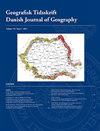飓风奥托的山洪影响和哥斯达黎加水文气象风险制图
IF 1.1
4区 社会学
Q4 ENVIRONMENTAL STUDIES
Geografisk Tidsskrift-Danish Journal of Geography
Pub Date : 2020-07-02
DOI:10.1080/00167223.2020.1822195
引用次数: 37
摘要
山洪是热带地区最具破坏性的自然灾害之一。季节性和异常降雨经常引发哥斯达黎加的山洪暴发。飓风奥托是有史以来第一个经过哥斯达黎加的飓风。这一现象造成的损失达1.9亿美元,仅在哥斯达黎加北部的乌帕拉市就造成4人伤亡和约6900万美元的损失。2016年11月24日,飓风奥托通过研究区,在6 h内产生了约300 mm的降雨。我们基于人口普查最小地统计单元进行了水文气象风险评估,给出了空间分布的风险矩阵评估。此外,我们将S1 GRD (Ground Range Detected)和VV偏振图像应用于Sentinel-1 SAR(合成孔径雷达)和WorldView-3和WorldView-4图像,确定了飓风奥托(Otto)影响后主要在Upala市的Zapote河、Cabeza de León和Guacalillo子盆地的暴洪区域。因此,我们将暴洪区与以往不同的水文气象风险区进行了比较。山洪暴发影响了约74平方公里,其中56%的地区属于高危区。这项研究的结果和方法可用于评估发展中国家和热带国家的异常水文气象灾害。本文章由计算机程序翻译,如有差异,请以英文原文为准。
Flash flood impacts of Hurricane Otto and hydrometeorological risk mapping in Costa Rica
ABSTRACT Flash floods are one of the most damaging natural hazards in tropics. Seasonal and extraordinary rainfall recurrently trigger flash floods in Costa Rica. Hurricane Otto was the first reported hurricane to have ever passed through Costa Rica. The phenomenon resulted in losses amounting to 190 million US$, leaving four casualties and ca. 69 million US$ of losses in Upala municipality in northern Costa Rica, alone. On November 24, 2016, the passage of Hurricane Otto produced ~300 mm of rain over the study region in 6 h. We carried out a hydrometeorological risk assessment based on population census minimum geostatistical units to present a spatially distributed risk matrix assessment. In addition, we applied an S1 GRD (Ground Range Detected) and VV polarization to Sentinel-1 SAR (synthetic aperture radar) and WorldView-3 and WorldView-4 images to determine the flash-flooded areas just after Hurricane Otto’s impact in the Zapote River, Cabeza de León and Guacalillo sub-basins mainly in Upala municipality. Consequently, we compared the flash-flooded areas with the different previous hydrometeorological risk zones. Flash floods affected ~74 km2 and 56% of these areas coincided with high-risk zones. The results and methodology of this study can be useful to assess extraordinary hydrometeorological hazards in developing and tropical countries.
求助全文
通过发布文献求助,成功后即可免费获取论文全文。
去求助
来源期刊
CiteScore
5.20
自引率
0.00%
发文量
5
期刊介绍:
DJG is an interdisciplinary, international journal that publishes peer reviewed research articles on all aspects of geography. Coverage includes such topics as human geography, physical geography, human-environment interactions, Earth Observation, and Geographical Information Science. DJG also welcomes articles which address geographical perspectives of e.g. environmental studies, development studies, planning, landscape ecology and sustainability science. In addition to full-length papers, DJG publishes research notes. The journal has two annual issues. Authors from all parts of the world working within geography or related fields are invited to publish their research in the journal.

 求助内容:
求助内容: 应助结果提醒方式:
应助结果提醒方式:


